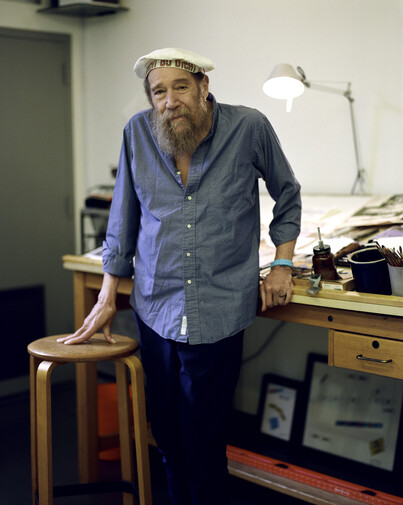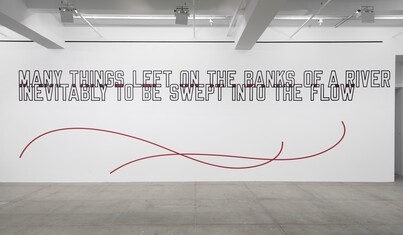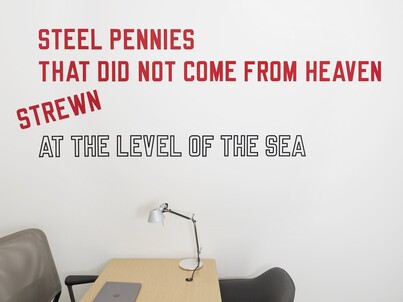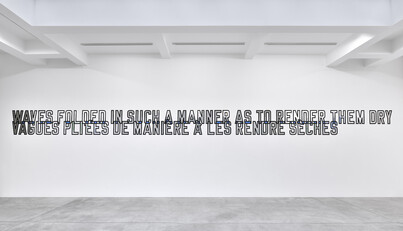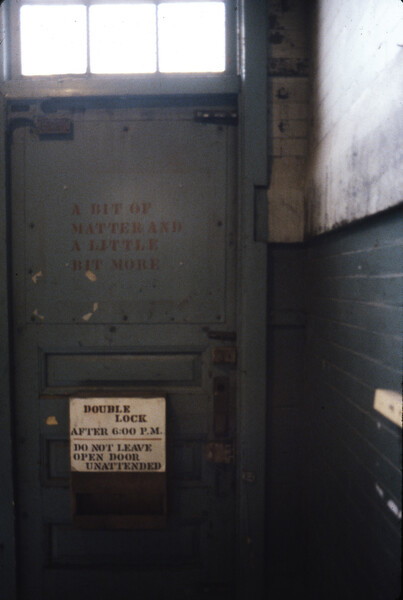
The online tributes that began pouring out immediately after Lawrence Weiner’s FIG.1 death on 2nd December 2021 at the age of seventy-nine were unanimous: ‘a towering figure in the Conceptual art movement’ (Artforum), ‘a pioneering conceptualist’ (Artnet), ‘giant of Conceptual art’ (ARTnews).1 And who could argue with that? The third line of his 1968 ‘Statement of intent’ makes it clear:
1. The artist may construct the piece
2. The piece may be fabricated
3. The piece need not be built2
This suggests that a work of art is a mental entity – una cosa mentale, as Leonardo da Vinci had declared centuries earlier – the existence of which is independent of how, or even whether, it is made.
Well, one person who liked to argue against the idea of Weiner as a Conceptual artist was Weiner himself. At least later in his life, when I got to know him, he roundly rejected the label. He would say that ‘Conceptual art’ might have been an apt designation for the work of some of his old allies from the late 1960s, when the new work they were doing was so poorly understood. But he was up to something very different than, for instance, Joseph Kosuth (b.1945). ‘My work is not about ideas’, he asserted, ‘it’s about materials!’.3 Although his works normally took the form of words on a wall, he stated that he was essentially a sculptor, or that he felt closer to a painter like Mary Heilmann (b.1940) than to some of the artists he had exhibited with under the Conceptualist banner.
Now, I will admit that Weiner’s statements should sometimes be taken with a grain of salt. Opinionated as he was about almost everything, it was impossible not to notice that the passionately intransigent position he expressed about any given issue could be succeeded, next time one saw him, by an equally passionate stance that was quite different. It was only the passion that remained constant. But still, his rejection of the Conceptual art label and his insistence on materials as the fundamental subject of his work was, in my experience, also steadfast. It is telling that he always captioned his works not with, say, ‘vinyl lettering on wall’ or ‘paint on wall’, but ‘language and the materials referred to’. That meant that, when in 1996 he participated in a show I curated with the piece BLACK POWDER SPREAD EVENLY OR WHITE POWDER ANYWHERE (1996), he was asking the viewer – or, as he preferred to say, the receiver – to understand the work as being made of powder carefully spread around, even though one might not know whether it was black or white or what it was made of (salt or pepper? Saltpetre or gunpowder?) or just where it might be, in addition to the words used to communicate this.
For Weiner, that his work concerned materials distinguished it, not only from Conceptual art, but also from poetry. Here, I found his opinion less reasonable. Poetry, he would say, had to do with subjectivity, with emotion, whereas materials are objective. He did not take into consideration that, although it was probably true that most poetry concerns subjectivity, this is not part of its definition, and that some poetry abjures it as much as his work does. William Carlos Williams’s ‘The Red Wheelbarrow’:
so much depends
upon
a red wheel
barrow
glazed with rain
water
beside the white
chickens4
is exactly as objective as, say, Weiner’s MANY THINGS LEFT OF THE BANKS OF A RIVER INEVITABLY TO BE SWEPT INTO THE FLOW FIG.2 or his STEEL PENNIES THAT DID NOT COME FROM HEAVEN STREWN AT THE LEVEL OF THE SEA FIG.3. Admittedly, there were also more enigmatic things, such as WAVES FOLDED IN SUCH A MANNER AS TO RENDER THEM DRY FIG.4. I could never help but see Weiner’s elevation of materials over ideas as a descendent of Williams’s ‘no ideas but in things’ and Francis Ponge’s Le parti pris des choses (Taking the Side of Things; 1942). And if the remnant of subjectivity evident in Ponge’s ‘parti pris’ or if the ‘so much depends / upon’ is more tacit in Weiner’s works, it is still there. When he posits A BIT OF MATTER AND A LITTLE BIT MORE FIG.5 he leaves the question open: a little bit more matter, or a little bit more than matter?
Besides, in its own understated way, Weiner’s work was always touching on metaphor, even myth. It evokes a life lived in a fluid medium: the sea, a river, a canal. This native New Yorker who had been a merchant seaman in his youth was the sometime resident of a houseboat in Amsterdam, and it would always be true for him that, as one of his works had it, rhymingly, ON BOARD THE SHIPS AT SEA ARE WE (2019). ‘At sea’ means, among other things, to not be in control of one’s fate, and Weiner’s art was always cognisant of that. A person, as much as anything else, might be AN OBJECT TOSSED FROM ONE COUNTRY TO ANOTHER FIG.6.
The positive side of being ‘at sea’ was a certain detachment from the idea of the nation and of the restrictions it imposes in exchange for its rewards. Weiner always nurtured such a quasi-anarchist distance from the state. He once told me that in becoming a professor at Kunstakademie Düsseldorf, Joseph Beuys (1921–86) had undermined his own ideals – he had become a civil servant. Weiner, who never attended a university or art school, was sceptical of formal education. He was so happy when in 1995 the New York Public Library made a retrospective of his books; this, he said, was where he received his education.
Returning to that ‘Statement of intent’, what counts is that the work is a meeting point between the artist’s effort and someone else’s effort to come to terms with it. The artist can make the work or have someone else make it or not, that is not the point; instead, it is that ‘Each being equal and consistent with the intent of the artist the decision as to condition rests with the receiver upon the occasion of receivership’.5 That occasion, Weiner knew, was unpredictable – we are CAUGHT BETWEEN SHIPS PASSING IN THE NIGHT (1999).




